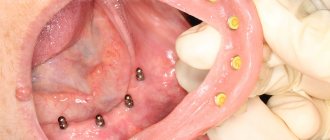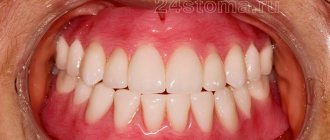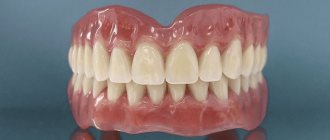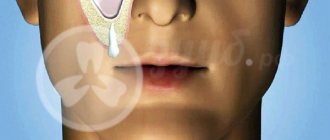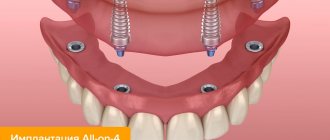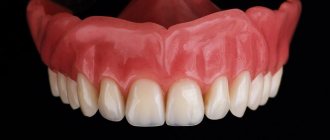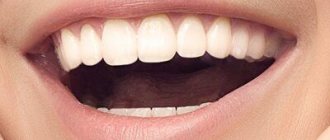- Questions and answers
- Stock
- Reviews
- Prices
- Methods and steps
| Prices | Technologies and stages | All-on-4 prosthetics | All-on-6 prosthetics |
Today, there are various implantation technologies for complete absence of teeth, which are used depending on the clinical picture and financial capabilities of the patient. What are the features of these methods? How to choose the optimal technology? How much does it cost to get full dental implantation in Moscow at NovaDent dental clinics?
Reasons for missing teeth
1-2% of the population has a genetic disorder in which teeth are initially absent or their number is abnormally small. In the vast majority of cases, the absence of lower or upper teeth is a consequence of illness or mechanical damage. Doctors at the clinic name the main reasons:
- Untreated caries or pulpitis. Tooth tissues are destroyed, in advanced cases, inflammatory processes in the gums begin, and the bone structure changes. Our dentists try to preserve every unit. But, if the process is already irreversible, then it is necessary to remove one tooth or several.
- Inflammatory processes in periodontal tissues lead to the fact that the ligament cannot hold the tooth in the socket. The crown becomes loose, destructive phenomena progress, and the gums and bone are destroyed.
- Injuries. The complete absence of teeth or partial adentia is caused by dislocations, bruises, fractures of the tooth crown or root, and other damage resulting from mechanical impact.
Sometimes teeth can be lost after suffering from somatic diseases: oncological, endocrine, and others that weaken the immune system and affect the structure of tissues.
Why do you need to restore your teeth?
Edentia is not only discomfort, but also early aging. The absence of teeth leads to changes in facial features, sunken cheeks, and the appearance of deep wrinkles. The person looks older, his appearance becomes sickly. In addition to visible imbalances in proportions and a deterioration in the quality of life, when there are no teeth at all, health problems
:
- The diet is reduced, the body does not receive the required amount of vitamins and minerals. The immune system suffers, metabolic processes are disrupted, and cells do not receive enough nutrients.
- Gastrointestinal diseases are provoked. Food is chopped poorly, making digestion difficult. Sometimes patients switch to eating pureed food or pureed food - this method also contributes to the appearance of dysfunction of the stomach and intestines.
- The absence of teeth in the jaws leads to improper distribution of the load on the gums and bone. Tissues atrophy and become thinner.
The bite also changes, diction is impaired - speech is slurred, most sounds are distorted. The absence of teeth affects the emotional state, lowers self-esteem, and the circle of friends narrows. Researchers have also established a direct connection with the presence of teeth and the state of intelligence and activity of older people.
Features of complete prosthetics
The clinics of the German Implantology Center in Moscow are a team of expert dentists who constantly improve their skills, participate in domestic and foreign symposiums, and introduce innovations. For more than 11 years of successful dental practice, we have been able to become a leader not only in Moscow, but also in Russia in the field of implantation and prosthetics.
Therefore, dental restoration in our clinics is as comfortable and painless for you as possible - safe anesthesia and sedation are used. The doctor tells you what symptoms may appear in the first days after surgery and prescribes medications appropriate to the case. The doctor is always in touch with the patient until complete healing.
Advantages of the “Teeth in 1 Day” method:
- The operation can be performed in the presence of bone tissue atrophy and some chronic diseases;
- Preparation takes minimal time;
- The minimally invasive operation is performed immediately after the removal of natural teeth;
- Prosthetics are possible on the day of surgery;
- The quality of original products meets high quality standards;
- The service life of implants is 25 years, temporary prosthesis - 3 years, permanent prosthesis up to 15 years;
- Optimal price-quality ratio.
Prosthetics of the upper jaw on implants
Implantation in the complete absence of teeth in the upper jaw has its own nuances: osteoporosis of the bone progresses faster, there is an anatomical feature - a low alveolar ridge (its height is not enough to hold the pin), and the proximity of the maxillary sinus complicates the process.
The classic two-stage method is rarely used in this case. Bone grafting is an additional surgical intervention, and our doctors perform surgery when it is unavoidable. Therefore, preference is given to immediate implantation or gentle techniques.
All on 4 systems
"or "
All on 6
" allow you to quickly, with minimal trauma, restore the dentition when complete dental prosthetics are required in the upper jaw. These techniques are suitable for those who want to get quick and high-quality results. They are well tolerated by older people. If you replace your teeth completely, the healing time of the implants will be up to six months.
The “All on 4” and “All on 6” protocols differ in the number of supporting implants. The first method is suitable for patients with slight thinning of the bone and a small jaw, the second is acceptable for moderate and severe atrophy.
When implanting “All on 4”, two (four) implants are installed at an angle of 35-45 degrees in the lateral (sometimes distal) section, and two more are installed vertically on the front part of the jaw. Implantation at an angle allows you to bypass the maxillary sinuses. Doctors prefer to install dental implants in a minimally invasive way - through a puncture.
If it is not possible to install 4 implants in the complete absence of teeth, then it is possible to implant 2 pins, which will support a removable denture - the structure will be fixed better than the simple version with suction cups, the use of additional gels is not required.
When the tubular bone is too thin, a sinus lift will be required - this is how the volume of the maxillary sinuses is reduced and the bottom is corrected (raised). The voids are filled with synthetic material biocompatible with tissues. Implantation is possible approximately two months after the sinus lift.
If inflammatory diseases are observed (sinusitis, sinusitis), there is a cyst, or a deviated nasal septum, then bone grafting is performed only after anomalies have been excluded - treatment or surgery.
One of the features of implantation in the absence of teeth in the upper jaw is that the front teeth and part of the gums are visible when talking or smiling. Therefore, doctors solve two important problems: restore health and create an aesthetic image. Often artificial teeth turn out to be more beautiful than those given by nature and form the natural contour of the gums. The exact location of the implant is determined based on diagnostic images.
If the bone tissue deficiency is too acute and the augmentation operation is irrational, then it is possible - but at the stage of temporary prosthetics - to install zygomatic implants. In this way, it is possible to replace teeth completely with a small amount of spongy bone mass.
- Extended pins guarantee reliable fixation of the prosthesis in cases of total bone tissue deficiency, osteomyelitis and other clinical cases.
- Titanium implants from the Nobel Biocare line with a porous surface and a special coating are designed for rapid osseointegration.
- Artificial roots are implanted through surgery under anesthesia, bypassing the paranasal sinuses, into the deep cortical layer of the zygomatic bone. This is a complex operation, which is used only in special cases.
Before the operation of implantation of implants in any jaw, the doctor draws up a detailed treatment plan, because not only the beauty of the structure, but also the adequate distribution of the load on the artificial tooth root depends on the accuracy of each action and the correct selection of models of implants and prostheses.
Example #3. Prosthetics of the upper jaw on 8 implants
Our patient is quite young. I contacted the German Implantology Center with the problem of swelling, swelling, bleeding gums, discomfort, accompanied by periodic pain.
Based on the diagnostic results, it was found that all (!) of the existing teeth in the upper jaw are completely untenable due to the previously not entirely successful treatment in other clinics. Unfortunately, this problem is quite common:
The result of implantation and prosthetics of example #3 is presented below:
This clinical case is reviewed in more detail HERE.
Example # 3.1 - Upper jaw prosthetics on 7 implants
Our patient is a 70-year-old man
. I contacted the German Implantology Center with the following problem:
- There are only a few teeth left on the upper jaw,
- Some of the destroyed teeth were roots.
Before making a decision, the patient was constrained by the fact that there were 7 teeth left in the upper anterior section. They provided some (tolerable for many men) aesthetics. But when the man finally fully analyzed the situation for himself, he realized that chewing with so many teeth was, to put it mildly, uncomfortable for him and agreed to a step-by-step and rather complicated dental prosthetics procedure for him. Why was dental prosthetics difficult? Because it was done in several stages, and not all at once in one operation.
We will also not dwell on this clinical case now; we will show BEFORE and AFTER photos.
This is the situation a patient came to us
:
And this is what we have as a result of prosthetics
:
You can view this rather complex clinical case in detail HERE.
Prosthetic options after tooth extraction: when should it be done?
How does the tooth extraction process work? Photo: Smile-at-Once
Modern and progressive dentists never rush to remove teeth unnecessarily. Today, even “wisdom teeth” are most often preserved if their treatment is appropriate and they do not interfere with closing the jaws. Nevertheless, sometimes it is still necessary to remove teeth. And after this, a completely logical question arises - what next?
A simple and quick answer - we wait for tissue restoration and deal with the issue of restoration. But in what way - “KP” figured it out together with experts.
Why do we lose teeth?
No one is immune from tooth loss, even if they are completely healthy. It’s easiest for children, because after their first breasts fall out, they will grow strong permanent ones. In adults, unfortunately, new ones do not appear, although scientists are trying to grow new ones from stem cells.
The most common cause of loss of front teeth, both in children and adults, is injury: bruises, falls, fights, biting nut shells, etc. The problem is also caused by poor oral hygiene, which causes caries, as well as gum inflammation and periodontitis.
Unbelievable but true! The most common disease is caries. If you run it, you can lose only 1-2 teeth. But inflammation of the gums, namely periodontitis, is considered the main reason that we lose a large number of teeth almost simultaneously.
An age-related slowdown in metabolism can also lead to tooth loss - tissue nutrition deteriorates, the protection of tooth enamel decreases, and the bone becomes less dense.
But the fact remains that you have lost a tooth, now you just have to decide what to do next and how to restore it.
Why can't you stay without teeth?
In addition to the fact that your smile will be unattractive and you will not be able to fully chew food, there are several other reasons for surgical dental restoration. We asked a specialist from the Smile-at-Once clinic, leading maxillofacial surgeon and implantologist Roman Bespalov, to comment on the situation:
“Your remaining teeth will shift and become loose. The bite is disrupted, which will lead to problems with the temporomandibular joint. Due to changes in nutrition, disturbances in the functioning of the gastrointestinal tract will appear. Not only the smile will change, but also the shape of the face, individual facial muscles lose tone, wrinkles and nasolabial folds appear, and the lips will become thinner. And the more teeth are missing, the more pronounced these consequences are.”
After losing teeth, changes will not take long to occur. Photo: Smile-at-Once
When can dentures be installed after tooth extraction?
Immediately after removal, the hole fills with blood - in about 2 hours it completely coagulates, after which a blood clot begins to form. This is a small ball or nodule that will remain on top of the gum for about 5–7 days: it covers the internal tissues from infection and serves as a “base” for the formation of new ones. In about 7–10 days, the wound is completely healed, and the gums become their usual pink color. But internal processes are still ongoing - bone tissue needs the most time to recover: it modulates and partially fills the hole in 4-6 months. Hence, certain restrictions arise for subsequent prosthetics.
• if you are planning to install a bridge : you will have to wait at least 3-4 weeks, since the hole must be completely filled with new tissue, because installing and adjusting the bridge is quite painful. Even for fitting, you will have to fix and remove the structure by prying it with a tool, the sharp edge of which will damage or infect the area healing after removal,
• if you are planning to install a removable denture : if we are talking about temporary replacement of just 1 tooth, then you can take impressions and prepare for dentures in 3-4 days. But if a lot has been removed, it is better to allow at least 20–30 days for the tissue to recover a little, including bone,
• if you are planning to undergo implantation : if there was time for preparation, you can place the implant immediately after removal, on the same day. And if there was no time, you will have to wait until the bone recovers - this is at least 3-4 months.
“Do not trust the removal of teeth to a dental therapist - the procedure should be carried out by a dental surgeon or even an oral and maxillofacial surgeon who can extract the tooth as sparingly as possible for all tissues. It is also recommended to immediately use special bone analogues or preparations for tissue regeneration in combination with special protective membranes, since bone tissue cannot be restored to its natural volume on its own. This is especially true if you are planning dental implantation in the future,” comments Roman Bespalov.
Which denture is suitable if several teeth are missing?
In general, there are three main methods for restoring teeth, but within each there are several dozen more subtypes, mainly based on the materials used. These are removable dentures (they rest on the gums and are held on by hooks on the remaining teeth), these are dental bridges or bridge-like dentures (neighboring supporting teeth are used to fix them), and there are also dentures supported by implants. The last type is called implantation. In the article at the link, we already talked about how you can restore all your teeth. Now we will talk about what to do for those who have single defects in the dentition.
And let's start with the most worthy option.
Prosthesis on implants
Implantation, like any other type of prosthetics, has certain disadvantages (it requires surgical intervention and is quite expensive). But still, it is many times better than removable or bridge dentures. And that's why.
Firstly, this is a physiological decision. You will have to replace not only the apex, but also the root, that is, all the tissues of the jaw system will work. Secondly, you will not have to sacrifice living teeth that are located at the edges of the defect. Thirdly, this is the most durable option. Of course, if you choose high-quality implants and a doctor who will install them in strict accordance with technology.
And if you look at your lifestyle, you can actually forget that you have a denture – teeth on implants are so comfortable and indistinguishable from natural ones. Once the implants take root, there will be virtually no restrictions in terms of food.
There is also good news - you can place an implant immediately after extracting the tooth root from the socket. But here it is important to take into account the fact that you need to be well prepared for implantation. That is, if you remove a tooth urgently, you cannot immediately place an implant - you need to study the condition of the bone, periodontal tissue, and assess your health. And if the operation is planned, then the two procedures can be easily combined with each other.
If one tooth is missing, then, as a rule, the most standard implantation protocol is used - it is called “classical or two-stage.” First, implants are installed, and after they have completely fused with the bone, a prosthesis is installed. This can be a crown made of metal ceramics, ceramic composite or zirconium dioxide, as well as a bridge prosthesis if several teeth are missing.
But there are some peculiarities: in a number of situations, the prosthesis can be installed much faster - immediately, after 2-4 weeks, or traditionally after 4-6 months. Let's take a closer look:
• the prosthesis is placed delayed - after 3-6 months: we are talking mainly about the lateral teeth with which we chew. This approach is relevant for most brands of implants - they are safe to load only when they have completely fused with the bone, that is, taken root. And speaking in medical terms, they become osseointegrated,
• the prosthesis is placed quickly: not immediately, but quickly - within a period of 3-4 to 6-8 weeks. This is only possible with some premium brands of implants, in particular Nobel or Straumann, which have an active surface and literally stimulate the growth of bone tissue cells. Due to this, their engraftment, as well as primary fixation, occurs faster,
• the prosthesis is placed immediately: if we talk about the absence of all teeth, then a fixed prosthesis can be installed already on the 3rd day after implantation - this can be done with modern implantation protocols with immediate loading. This is safe if the technology is followed - and the prosthesis itself fixes the position of the implants by combining them into a single system (a metal frame is created in the prosthesis for this purpose). But if 1-2 teeth are missing, then a permanent denture cannot be installed right away. Only a temporary crown, but a lighter one, can be attached to the implant. The doctor can also make it a little shorter in height so that this tooth does not participate in chewing. This way, the aesthetics will be restored immediately, and nothing will interfere with the implants taking root smoothly.
“70% of the success of implantation depends on the actions of doctors - a surgeon and an orthopedist. But it is important to make the right choice in favor of the brand of implants - I advise you not to skimp on your health, but to choose high-quality models that have been on the market for more than 20 years and have a large clinical and evidence base of success. Only original prosthetics should be installed - in particular, abutments of the same brand. They fit as accurately as possible - there are no gaps in which bacteria can accumulate, and this reduces the risk of rejection even after 10-15 years of using new teeth,” notes Roman Bespalov.
Removable denture
To restore 1-3 teeth, so-called “butterfly” dentures are used, which have “wings”, or more precisely, hooks that clasp the living teeth on both sides. Such prostheses can only be counted on as a temporary solution to the problem - they will not last long, since they have little support, and they hold up very poorly. In general, removable appliances have good fixation if they are attached on both sides of the row at once, but often patients lose their last chewing teeth and the attachment has to be done only on one side.
The removable butterfly prosthesis replaces only a couple of teeth, but holds up rather poorly.
In this prosthetic scenario, doctors strongly recommend remembering not only the inconvenience of the design, but also the fact that physiological changes occur - the teeth on which the prosthesis rests quickly fail due to overload. Bone atrophy also occurs, but here it’s the other way around – due to a lack of chewing load, because there are no tooth roots. Therefore, the bone under the prosthesis will gradually decrease along with the gum - a gap will appear, and the structure itself will hold up even worse than initially. And this, by the way, applies to any “pullers” – regardless of how many teeth they replace.
Which exit? Place removable dentures for a while, and then try to carry out implantation.
Bridge prosthesis
This prosthesis consists of at least three crowns. Those on the edges are placed on top of living roots. The central ones, as a rule, are 1–3 pieces, replace the lost ones. Such a prosthesis is non-removable and holds up very well, especially if the supporting teeth are initially healthy. The aesthetics are also high, since the crowns are located just below the gum level - artificial teeth look very natural. But all this is just at the beginning - the first 2-3 years, and if you’re lucky, then a maximum of 5-7 years.
The photo clearly demonstrates the effect that living teeth and various dentures have on the gums and bone tissue.
A dental bridge has a number of obvious disadvantages: lack of physiology - the supporting teeth are overloaded, and atrophy of all tissues occurs in the area of lost elements. Such dentures often have to be removed along with the destroyed supporting teeth after 5–7 years. And the bone and gums, which shrink in size, lead to the formation of a gap under the denture - food debris gets clogged there, rotting, tissue inflammation, pain and bad breath occur. In addition, if you have lost only 1 tooth, you will have to deliberately destroy two more, even if they are completely healthy - you will have to sharpen them heavily for the crowns of the bridge, and also remove the nerve.
Which exit? It is good to think about whether it is worth resorting to this option, because it is better to place an implant and not harm other teeth. If you still decide to go for it, then regularly check the condition of your supporting teeth at the dentist, and undergo professional oral hygiene every 6 months. This will extend the life of the bridge.
As you can see, there are few effective options for replacing an extracted tooth, and restoration cannot be delayed, otherwise the problem will result in large-scale damage.
Before removing a tooth, be sure to consult a surgeon and orthopedist, listen to their words, it may still be possible to preserve the root of the tooth, stop the inflammatory process in the bone and soft tissues. By assessing all the pros and cons of your situation, you can make an informed choice.
Prosthetics of the lower jaw on implants
The structure of the lower jaw is different - the bone mass is denser and thicker, the installation of a lower prosthesis in the absence of teeth, and the implantation of implants have other features.
“All on 4” protocols, as mentioned earlier, in most cases allow for complete restoration of teeth. The healing process is faster - the vast majority of patients forget about the presence of artificial teeth after three months. This is possible due to the increased density and sufficient height of the bone. The method is recommended for lack of volume (short length, thickness), atypical location of the mandibular canal.
Example #4 - All on 4 implantation with lower jaw prosthetics
Our patient is 82 (!) years old
. For the last 10 (!) years I have been trying to carry out treatment - restoration of the dentition with the help of implants. But, unfortunately for him, it was not successful - the implants were lost for a number of reasons - they did not take root, they became inflamed. But we must give our patient his due - he did not lose hope. A man of very progressive thinking, he understood that the problem was not in his body, but that something else was happening that was preventing him from becoming the happy owner of a high-quality denture on implants.
The result of “All on 4” prosthetics is presented in the photo below:
More details about this interesting clinical case can be found HERE.
About Us
The international center for dental implantation "EspaDent" is a modern medical center in Moscow near the Dynamo metro station. The clinic has the latest equipment and highly qualified staff. The main areas of work are: dental implantation, prosthetics, bite correction (orthodontics), artistic restoration and teeth whitening.
The main goal of our activities is to introduce implant prosthetics using the ALL-ON-4 method into everyday practice and to popularize this method both among doctors and patients. We want high-quality dental implantation to be available to as many people as possible, regardless of their income and area or region of their residence. Come to us and you will, without a doubt, be satisfied with the result of the treatment. EspaDent - Your dentistry!
Features of implantation and prosthetics on the lower jaw
The artificial root is more firmly fixed in the tissue, so the risk of rejection tends to zero. The mandibular bone atrophies more slowly after the loss of units, which reduces the likelihood of osteoplasty. For complete dental prosthetics on implants, we use the “All on 6” technique more often in most clinical cases. This guarantees the patient reliability and ease of use of the orthopedic construction, primarily in the long term.
The aesthetic side is important, but when working with the dental row below, more attention is paid to restoring functionality. There is a nuance: the surgeon’s work will require precision, since the trigeminal nerve passes at the base of the jaw and there is a risk of damage to it if the intervention is careless.
- Before implantation begins, during diagnostics the exact location of the branch of the trigeminal nerve is established, the structure of the tissues and the localization of nerves and vessels are clarified.
- Surgeons at the Research Center clinics are highly qualified, carry out diagnostics and know everything about the anatomical features of each patient, so implantation takes place without complications.
- The doctor selects not only the location of the implant, but also its size, which is especially important in the absence of teeth. If the location is too close, then the nerve trunk will need to be docked.
Example #5 - Lower jaw prosthetics on 6 implants ALL ON 6
Our patient is a woman with fairly progressive views on dental treatment and prosthetics. But a rather serious problem in her life is an allergy to antibiotics. Since she categorically did not want a removable denture, considering it archaic and uncomfortable, the patient began her independent attempts to improve her smile. And she did this at her own peril and risk in several clinics.
At first, she installed the implants without “covering up”—the subsequent use—of antibiotics. Some of the implantation went well, some not so much. Having suffered, the patient concluded that she still needed to turn to professionals and then, even without antibiotics, she would get the reliable and aesthetically beautiful result that she dreams of and really wants to achieve.
The photo shows a view of 6 implants installed on the lower jaw:
Photo after prosthetics
:
You can read more about this interesting clinical case HERE.
Which prosthetics for the lower jaw is better?
Patients are often interested in which prosthetics are best for restoring lower jaw teeth. Progressive experts believe that implantation and installation of structures today is the optimal and gentle option to maintain quality of life at any age. Root-shaped implants for the lower units are selected taking into account the upcoming high chewing load.
We use the basal method of prosthetics on implants extremely rarely and only at the stage of temporary prosthetics in the distal part as part of the “All on 6 implants” protocol in the absence of teeth, severe tissue atrophy and the inability to install 2 classical artificial roots. Then the elongated implants are introduced into the deep layers of the jawbone during the formation of bone in the distal section after bone grafting. After the bone tissue has formed, the basal implants are removed and normal classical implants take their place. And after this, the patient undergoes permanent prosthetics on 6 implants.
Modern implant designs are characterized by directional threading; some models have a porous surface with a coating that accelerates the integration of the artificial root into the bone. Fixed dentures in the absence of teeth are installed on a larger number of supports, minimum 6-8. One- or two-stage protocols are warranted. In the first option, until complete engraftment, the patient wears a traditional removable denture; in the second, a temporary option with artificial gums attached to pins is installed.
The fixed structure consists of metal-free crowns (usually zirconium dioxide), there is no artificial gum, and there is no need to remove the denture for cleaning. It is enough to follow standard hygiene procedures.
The “All on 4” protocol is ideal for restoring missing teeth in the lower jaw, if it is small, and allows, in most cases, to avoid bone augmentation. This is usually a one-stage implantation with immediate loading. Primary stabilization is high, there is an orthopedic stage. Within a week after the implants are inserted, a temporary prosthesis is put on.
If the bone has atrophied and for some reason it is decided to give preference to classical implantation, then bone grafting will be required. Special membrane materials are used that are embedded in the bone and stimulate its development. After osteoplasty there is a rehabilitation period of 4 months. up to six months.
What determines the cost of prosthetics?
How much does tooth replacement cost? To answer the question, you need to take into account that there are various options for restoring the dentition. They differ in design characteristics and cost, which depends on the type of prosthesis, the material from which it is made, and the work of the doctor.
Prosthetics are carried out using removable and fixed dentures and implants.
Removable prosthetics:
- dentures made of acrylic - the most budget type of design (the price consists of the cost of manufacturing and installation);
- Clasp removable dentures are more expensive (the price depends on the coverage area and the method of attachment).
Fixed prosthetics:
- artificial crowns made of metal (available, cheap, but not very aesthetically pleasing method); metal ceramics (reasonable cost and high aesthetics); ceramics (highly aesthetic, the most expensive will be a product made of zirconium dioxide);
- bridge structures - metal-ceramic, ceramic (made of expensive zirconium dioxide) and adhesive (the cheapest option);
- inlays (from cheap porcelain to expensive alloys of precious metals);
- ceramic and composite veneers (porcelain has the lowest price, zirconium dioxide has the highest price).
Pricing for prosthetics using implants includes the cost of:
- preparatory period (detailed diagnostics, modeling, preparation of bone tissue);
- implantation surgeries (includes the cost of the implant and abutment, anesthesia);
- prosthetics (installation of crowns).
At NovaDent clinics, prosthetics are performed using the All-on-4 and All-on-6 methods, using fewer supports for installing the prosthesis.
We work every day. Contact your nearest NovaDent clinic to find out how much it costs to replace a tooth. The doctor will suggest a treatment method and inform you about the cost of the work.
The addresses of all NovaDent clinics in Moscow and the region are listed on the website. Here you can also find the price list for dental services and information about current promotions and special offers. There is an installment plan for complex treatment; it is possible to pay for implantation on credit.
Expert of the article you are reading: Kuzmenko Viktor Valerievich Orthopedist, surgeon, leading specialist of the NovaDent network
17 years
Clinical experience
Krasnogorsk
Moscow region, Krasnogorsk, Podmoskovny Boulevard, 5
+7
Free consultation with this specialist
We insert the teeth completely: prosthetics of two jaws
Which prosthesis should I choose if I have no teeth at all? Contact the German Implantology Center - the doctor will choose a way to restore your health. Preference is given to implantation. The statement that it is expensive is outdated. Today you can get an installment plan. Implants are installed once and with a lifetime guarantee - clinic dentists work only with the premium segment from well-known manufacturers, and expensive traditional removable structures wear out and require replacement after 7-10 years.
Our Center is a certified partner of top-rated implant brands, which is why patients all over Russia and abroad trust us. If it is necessary to restore the dentition on two jaws, the treating doctor will prescribe an examination and draw up a detailed action plan for dental prosthetics on implants. A tomogram is performed, a 3D model or surgical template is created, providing a predictable result. We use the best tomograph models in the world – cone versions of the Planmeca line.
The dentist chooses the priority of actions and introduces implants according to the “All on 4” or “All on 6” protocols. These are ways to carefully, avoiding unnecessary trauma, improve the quality of life.
Dental implantation is completely performed in most cases without bone grafting.
- For total rehabilitation, sometimes 4 implants are enough to fix the prosthesis on the lower jaw - this is 20% of all requests.
- The bone of the upper jaw is more porous, so 6 supports may be needed to secure the structure - the need to use one of the methods will be discussed by the doctor during a consultation after the examination.
The treatment plan must be discussed with the patient.
Example #6 - Prosthetics of both jaws with implantation ALL ON 6
Our patient is a 49-year-old man. I came across the following difficult situation:
- severe periodontitis,
- partial absence of teeth,
- numerous caries, incl. deep
- bone tissue atrophy.
The situation was more than serious, look for yourself at the photo BEFORE the start of treatment
:
The result of the prosthetics exceeded all the patient’s wildest expectations, see for yourself:
And with a smile, the result of ALL ON 6 is simply fantastically beautiful:
You can read this clinical case in detail HERE.
Full implantation for edentulous patients is the optimal method of tooth restoration
You can restore chewing function with complete edentia using:
- removable acrylic or clasp dentures fixed on the gums and upper palate using a vacuum method or a special corrector cream;
- conditionally removable or fixed dentures supported by dental implants.
Removable dentures are relatively inexpensive, but they create a lot of inconvenience, ranging from mobility of the denture during chewing to increased sensitivity and an increased feeling of nausea.
Prosthetics of all teeth on implants completely solves these problems. Moreover, implantation improves the patient’s quality of life, since:
- prevents further bone tissue atrophy;
- improves chewing function, protecting against diseases of the stomach and duodenum;
- restores the aesthetics of a smile;
- provides reliable fixation of prostheses;
- returns a feeling of naturalness and makes you forget about these problems for decades.
In the absence of contraindications, such as diabetes, tuberculosis, oncology and hemophilia, implantation is the best way to restore teeth in completely edentulous upper and lower jaws.
